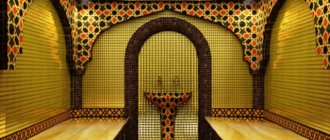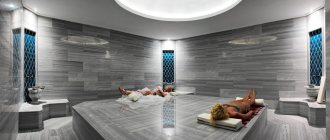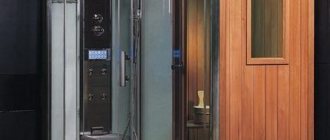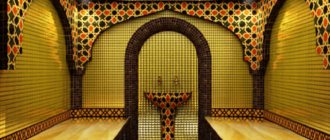Finnish sauna is dry heat with a tonic effect, hammam is an oriental ritual aimed at relaxation. It is impossible to say unequivocally which is healthier, a sauna or a hammam - there are too many differences both in the surroundings of both rituals, and in the mechanism of action of each bath.
To choose “your” steam room, you can go in two ways - based on a specific goal (indications) or conduct an experiment and make a choice based on personal feelings. For example, the gentle warmth of a hammam is ideal for getting to know bath culture in general, and a sauna is for seasoned people with a strong cardiovascular system.
Features of the Turkish bath (hamam)
The popular Turkish bath, or other “boorish”, is an effective type of steam room, which, although similar in purpose, differs in its operating principle. Among the main features of this type of steam room, it is necessary to highlight the reduced temperature regime. Inside, the room warms up to only 35-52 degrees. Humidity constantly remains between 90-95%.
The surface of the ceiling in a Turkish steam room always remains cool, which allows steam to settle on it and successfully transform into condensate. The hammam has several rooms: some are of technical importance, others are of bathing value.
Steam generation in Turkish baths Source etstur.com
The first group of premises includes those in which heating equipment is installed and various types of equipment are stored. It is in the utility block that steam is generated and delivered directly to the steam room through specially equipped channels. To make the steam room work more efficiently, they are now trying to use steam generators that supply heat evenly to the room. This ensures high-quality heating of the floor walls and beds.
Beds in the hammam, decorated with pixel tiles Source hot source45.rf
Phytosaunas
Today, phytosaunas have become quite widespread. Among their features, we note the following points:
- This design combines the effects of steam and saturated medicinal herbs.
- The structure is made of Siberian cedar; the substances released from this wood have a beneficial effect.
- Quite often, a steam line is connected to the structure, through which a healing herbal infusion is supplied.
- The steam temperature is maintained in the range from 25 to 55 degrees Celsius. Due to this, the procedure can be carried out over a long period, which determines the long-term beneficial effects of steam.
- Steam circulates freely throughout the system, thereby significantly increasing the efficiency of this procedure. To do this, the design has a compressor that creates pressure to circulate steam in the system.
- Wood cedar produces phytoncides that can fight various microorganisms. That is why the procedure has an antiseptic effect.
The design of most phytosaunas allows the use of both dry decoction and various balms. Due to this, the degree of beneficial effects of the procedure can increase.
In conclusion, we note that there are indications and contraindications for prescribing the bath procedure. Among the indications we note:
- Diseases of the upper tract.
- Problems with the musculoskeletal system.
- Exudative diathesis.
- Injuries of the lower extremities.
- Primary signs of hypertension.
However, there are quite a few serious contraindications:
- Epilepsy.
- Various infectious diseases that affect the skin.
- Various tumors.
- Bleeding.
- Blood problems.
In addition, a bath should be prescribed with caution for children or pregnant women. Heart problems are also quite often the reason why taking a bath leads to even greater problems.
There are quite a few different recommendations on how bath procedures should be carried out. So, many experts recommend gradually increasing the temperature, as well as the duration of stay in the steam room. Also, you should not jump into the pool immediately after the steam room, as a sharp temperature change has a serious effect on the body. If there are chronic health problems, air parameters should be selected individually.
Video description
Bath, Hammam, Sauna - what's the difference?
The design of the steam room involves the organization of three internal rooms:
- locker room This small unit maintains a temperature of 32-40 degrees. Here the vacationer can leave his clothes. The tap in the room is of little importance, so things will not get wet. Often a shower stall is installed in this room, which can be used after steaming the body;
- steam room A room in which people actually steam. The air temperature reaches 42-55 degrees and above, and moist steam is supplied here, which a person physically feels. The air in the room can be scented using special oils that are beneficial for the respiratory system. The spacious hammams have additional rooms in which, if desired, you can increase the air temperature above 68 degrees;
- relaxation zone. This is the last room in which you can relax and unwind after visiting the steam room. This room is equipped with some furniture, chairs and a table, and dishes. The air in this room does not warm up above 30 degrees. Therefore, the steamed body is very comfortable here.
When arranging hammams, you can equip technical rooms with boilers, observing old traditions. The water boiling in them will supply steam through special passages into the steam room.
Foam massage performed in a hammam to cleanse the skin and normalize metabolism Source green.am
When to visit the hammam
A visit to the Turkish bath is justified in several of the following cases:
- effective care for facial skin and hair due to the expansion of pores;
- strengthening and improving the functioning of the cardiovascular system;
- rejuvenation;
- aromatherapy and the need to prepare for cosmetic procedures.
Thanks to the action of moist steam, the epidermis is moisturized and softened. As a result, dead particles are removed and the skin begins to breathe.
Important! A person does not sweat in a Turkish bath. Drops on the body are condensation formed under the influence of moisture-containing steam.
Historical summary
It is a mistake to believe that the ancestor of the bathhouse is Ancient Rus'.
History proves that steam rooms existed in ancient historical times among different nations. Each nationality modified and added new elements in creating their own steam room. A bathhouse called “hamam” was inherited from Turkey, which means heat source in Arabic. The forefathers of eastern “hot” places are considered to be Roman baths. Muslims believed that in steam rooms sinners were washed from evil spirits that consumed body, soul and mind.
The Finnish sauna has been known for many years. Since its origins, the steam room has undergone few changes. The main features and features have been preserved to this day. In Finland, visiting the steam room is considered a mandatory ritual, a centuries-old tradition that should not be neglected.
In Russia, for a long time, the construction of a house began with the construction of a steam room. In many European cities, there were cases when visiting the bathhouse was banned, but the Russian steam room was still held in high esteem and people did not stop visiting it.
Features of the Finnish bath (sauna)
The Finnish bath, also known as a sauna, differs from the Turkish one in its operating principle and other features. Their main difference is the ability to generate steam that is too hot, but quite dry. It is noted that the air warms up in a steam room to 140 degrees, but the humidity level does not exceed 15%.
Wooden Finnish sauna with a firebox made of natural stone on wheels Source par-torg.com
What and how are they built from?
From the point of view of construction, the Finnish sauna is most similar to a Russian bath: both are built of wood, the interior decoration is also made of wood. They have a separate room with a high temperature, where they stay for a short period of time: a steam room. There is a separate dedicated room for water procedures and another one for relaxation. In this, both the Russian bath and the Finnish sauna are similar.
Turkish hammam is a clay or stone (brick) structure, lined with different types of stone. Ideally it is marble, but any stone or ceramic tile will do. There is a dedicated dry changing room, and the rest is a vast hall with adjacent open rooms (without doors), where they wash and rest. There is another room in the hammam - a technical one - it contains a stove and a steam generator.
Finnish sauna
Video description
Finnish sauna: benefits and harms, contraindications.
When is it advisable to visit the sauna?
Construction of a sauna in the private sector will be justified if necessary:
- deoxidize the body, that is, remove toxins;
- get rid of stress and fatigue;
- increase performance;
- strengthen the immune system and vascular system;
- stabilize the function of the upper respiratory tract;
- eliminate overtraining (typical for athletes).
Regular stay in a Finnish sauna guarantees relief from chronic diseases of the respiratory system.
Sauna for relaxation and strengthening the immune system Source na-dache.pro
Training
Let’s answer the question: “what is better: a sauna or a hammam after a workout?” There is no clear answer here.
The sauna helps to disperse lactic acid accumulated in the muscles, relieving them of pain. After a sauna, fitness trainers recommend stretching in order to maximally and properly train your muscles.
Hammam after training allows you to recuperate well, relax, restore breathing, improve the activity of the sebaceous glands, tighten and cleanse the skin. The body warms up deeply, but there is no stress on the heart. It is useful to visit hammam both before and after training.
We also recommend
- Infrared proximity sensor Video of sensor operation
- How to make a metal detector with your own hands: principle of operation, diagrams, step-by-step instructions Russian circuits of a metal detector for great depths
- Do-it-yourself taiga ax, features and varieties
- Not quite an ordinary “button”
- How to make an ax with your own hands: a master class on making an ax handle, drawings with dimensions and sharpening diagram
- How to get rid of mole crickets Repelling mole crickets from plastic bottles
Technical details
As has already been explained, a bathhouse differs from a sauna in its thermal regime. In a sauna, it is necessary to provide the highest quality air heating in order for it to be used effectively. For this purpose, stoves are installed in it, which quickly transfer heat. A metal casing is also installed, when air passes through it, it heats up. Then it hits the ceiling, is reflected from it and spreads throughout the entire area of the steam room. In saunas, the air is heated faster due to the active movement of warm masses.
Diagram depicting the movement of air masses in a sauna Source odstroy.ru
As for the hammam, a specialized steam generator is used to generate heat. Hot steam from it enters through the provided channels and exits into the room. At the same time, the walls warm up. The coolant comes out at a temperature of 100 degrees and it turns out very wet. In modern construction of a Turkish bath, heated seats and beds are used according to the principle of a warm floor. Under them there are pipes with water, which is heated from a boiler or general heating installed in the house.
Home sauna with bath and shower in different rooms Source waysi.ru
Building a hammam yourself
- The room must have a ventilation hood. To prevent moisture from entering the general ventilation system, an air dehumidifier should be installed in front of it. The ventilation valve must be open at all times.
- The sewerage system must be equipped with a drain with an odor-blocking device.
- A modern Turkish sauna is heated using a special steam generator.
- To heat the floor, walls and seats, water or electric heating is installed. It is better to choose a water one, as it is more profitable to use and from an economic point of view. It consists of small-diameter pipes laid in three independent circuits (for seats, floors, walls) with hot water moving through them.
- The room must be well insulated and waterproofed. The total pie of the walls together with insulation is approximately 7-15 cm. The pie includes mineral wool 5-10 cm thick, heat-reflecting insulation, a waterproofing layer, a heating system, plaster or cement screed for leveling the walls. Marble, ceramic tiles, mosaics made of marble, glass or ceramics are used as cladding.
- The operating temperature must be above 30°C. Heated surfaces must be turned on 6-8 hours before the procedure. The heating temperature should be set to 45°C. The steam generator is started 1-2 hours before the procedure.
- You should purchase a steam generator that will fit the parameters of the room. It has a built-in temperature sensor that turns it off if the room temperature becomes higher than the set temperature. The steam generator is also equipped with an automatic flushing system. The device is connected to centralized water supply and electricity. In private residential buildings it is connected to a separate circuit. This is done so as not to turn on the heating of the entire house during the warm season.
- For wiring, use only cables that can withstand high temperatures. For lighting, it is allowed to use only those lamps that are protected from moisture.
In Russia, the most common are steam generators produced by Tylo (Sweden), Helo (Finland), Harvia (Finland).
Conclusion
Roman bath
One of the most ancient types of baths. In fact, the baths are prototypes of Turkish hammams. These are also stone buildings with central heating and heated floors and walls. The modern Roman bath is distinguished by marble-clad rooms with heated marble loungers. The thermal bath was divided into separate rooms that had to be visited sequentially. They were called: caldarium, tepidarium, frigidarium.
The modern caldarium is a room decorated with ceramic tiles, heated floors and a large bathtub with water. Humidity in the caldarium is kept at 80-100%, temperature 37-45 ⁰C. The room is usually filled with the aromas of essential oils of healthy herbs and plants. Great importance is attached to design; caldariums are usually decorated in warm colors, with picturesque paintings from the life of Ancient Rome placed on the walls.
Tepidarium is a room with dry warm air. The temperature here, just like in the caldarium, is maintained at 37-45 ⁰C, but the humidity is much lower, only 30%. The tepidarium is equipped with marble beds and armchairs. Heating, as in all rooms of the Roman baths, is carried out from below. The tepidarium is comfortable for a fairly long stay. After visiting it, the body will require replenishment of moisture.
Frigidarium is a cool room with a swimming pool, where you go after visiting the tepidarium and caldarium to refresh and relax.
The effect of heat on the human body
The temperature and humidity in the bathhouse have a strong impact on your well-being. During your stay in the steam room, your body temperature rises. During the first 10 minutes, the skin warms up, and then, in the next 10, the internal organs. To ensure the correct process of sweat separation, it is necessary to wipe it from time to time (read: “The right sauna - how often to visit and other recommendations”).
As blood circulation accelerates, pressure rises. The bath is useful for people who suffer from blood stagnation in the extremities. However, for those who have problems with the heart and blood vessels, the steam room can be harmful.
But some diseases can, if not get rid of, then significantly alleviate their course, provided that you regularly take procedures in the steam room.
These include:
- frequent colds;
- obesity;
- allergy;
- circulatory disorders.
Increasing the intensity of blood flow has a beneficial effect on the nutrition of the body's cells, to which the substances necessary for this are quickly delivered. This process stimulates tissue regeneration and healing. The atmosphere in the steam room creates conditions for stress on the heart, which to some extent is a useful workout for it.
The high temperature of the water bath heats the skin, which leads to profuse sweating and rapid loss of moisture from the body. Together with sweat, a person gets rid of some of the toxins and heavy metals. This to some extent reduces the load on the kidneys and liver, which are also responsible for detoxification. Opening the pores of the skin allows it to be cleared of dirt and acquire a healthy color.
The process of warming up the body in the steam room has a positive effect on the condition of the muscles. The created conditions accelerate the metabolism of muscle tissue, removing lactic acid from it, which is necessary to restore their elasticity and relieve fatigue. Warming has no less benefit on the joints, providing them with more substances necessary for normal functioning.
We suggest you read: Is it possible to take a steam bath when you cough?
When going to this place, many people set out to not only steam their body, but also get a dose of relaxation and tranquility. This is a place where emotional stress is reduced through physical relaxation. Here everything happens slowly and deliberately. You should go here with a good mood and the desire to have fun.
All the described effects that the temperature in the bath has on the human body are achieved by following the recommendations for visiting it correctly.
Summary
There are some differences between a hammam and a sauna, but both options are quite popular. They fulfill one main goal - they improve overall well-being and prevent many diseases. In addition, people can gather here to spend pleasant free time, chat with friends, drink green tea and just relax. After all, sometimes you need to escape from that daily routine, stressful situations and just enjoy life. And the person himself chooses in which room to steam. After all, each option will have its own connoisseur.
You can order finishing for the hammam on our website or by calling: 8 (499) 110-97-56.
Arrangement of the area near the steam room
Simple arrangement of the area near the steam room does not require much effort. For ease of access to the bathhouse, it is worth laying a path to it. You can cover it with rubber tiles, crumbs, or garden parquet, but it is better to use small logs cut in half along the trunk. This method of arrangement is environmentally friendly and you can do it yourself.
If you have the funds, you can make a pool with a size of no more than 5 by 5 meters near the bathhouse, install a gazebo with a barbecue, plant flower beds and arrange a small landscape park with dry riverbeds and streams, bridges, cart wheels and other interesting details.
In the summer, garden loungers, swings or deck chairs can be placed near the steam room so that each user of the room can spend half an hour in the fresh air.











